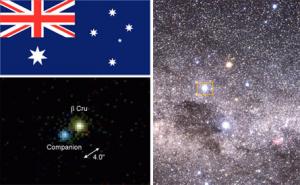A research team at Swarthmore College discovered a previously unknown companion to the bright star, beta Crucis, in the Southern Cross. As a prominent member of the well-known constellation Crux, or the Southern Cross, it appears on five national flags: Australia, Brazil, New Zealand, Papua New Guinea, and Samoa. The discovery was announced at the American Astronomical Society meeting held in Seattle January 5-10.

Clockwise, the Southern Cross is prominently displayed on Australia's flag, with beta Crucis just right of the Union Jack; an optical image of the Southern Cross, with beta Crucis indicated by the yellow rectangle and its newly discovered companion shown at the lower left; the Chandra image is color coded, with high energy x-rays colored blue, medium energy x-rays colored green, and lower energy x-rays colored red. (Image courtesy of Swarthmore College)
The companion star was discovered accidentally while the research team was using the orbiting Chandra X-ray Observatory to study the x-rays emitted by beta Crucis itself. "We were interested in how the highly supersonic stellar winds of hot, luminous stars produce x-rays," says team leader David Cohen, asssociate professor of astronomy. "We were surprised to see two strong x-ray sources where we had expected to see only one."
Astrophysics major Michael Kuhn '07 of Charlottesville, Va., presented the findings in Seattle. His work analyzing the x-ray data from both beta Crucis and its newly-discovered companion is the basis in a forthcoming paper on this project for the Monthly Notices of the Royal Astronomical Society.
Cohen' s research team also includes Swarthmore College Associate Professor of Astronomy Eric Jensen and Marc Gagné, assistant professor in the geology and astronomy department at West Chester University of Pennsylvania. Their project was funded by NASA and by a Eugene M. Lang Summer Research Fellowship from Swarthmore.
Located near Philadelphia, Swarthmore is a highly selective liberal arts college whose mission combines academic rigor with social responsibility. Swarthmore, with an enrollment of 1,450, is consistently ranked among the top liberal arts colleges in the country.
Note: This article has been adapted from a news release issued by Swarthmore College.


